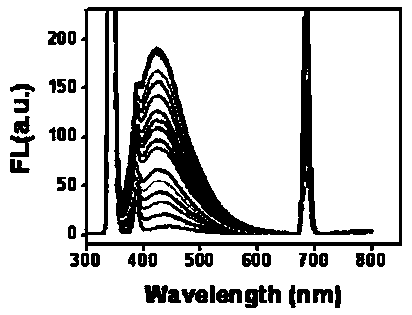A nitrogen-sulfur-doped graphene quantum dot and its preparation method and its application in the preparation of lysine fluorescence detection reagent
A graphene quantum dot and fluorescence detection technology, applied in the field of fluorescence detection, can solve the problems of cumbersome and inconvenient detection of lysine, and achieve the effects of excellent biocompatibility, good water dispersibility, and easy-to-obtain products.
- Summary
- Abstract
- Description
- Claims
- Application Information
AI Technical Summary
Problems solved by technology
Method used
Image
Examples
preparation example Construction
[0017] The preparation method of nitrogen-sulfur-doped graphene quantum dots is as follows: add citric acid and thiourea to a three-neck flask, add an appropriate amount of deionized water 5-35 mL, and stir to form a homogeneous solution. The mixed solution was transferred to a polytetrafluoroethylene-lined hydrothermal kettle. The mass ratio of citric acid and thiourea is 1:0.2~1:3, the heating time is 2~20 h, and the heating temperature is 130~230°C. The obtained product was dialyzed for three days with a dialysis bag with a molecular weight of 1000 to obtain the nitrogen-containing and sulfur-doped graphene quantum dots.
[0018] Preparation of lysine fluorescence detection reagent: the graphene quantum dots doped with nitrogen and sulfur are dissolved in water or alcohol aqueous solution, the aqueous solution is more practical and easy to use, and formulated to a certain concentration. The concentration can be determined according to the test conditions and the degree of ...
Embodiment 1
[0020] In fluorescence experiments, graphene quantum dots doped with nitrogen and sulfur were prepared as a 1.0 mg / mL aqueous stock solution, and amino acids and sugar molecules were selected from lysine, alanine, proline, glycine, methionine, and arginine , leucine, glucose, glucosamine, galactose, sucrose and other substances, all experimental solutions were newly configured and tested immediately. Excited at 340 nm, emitted at 440 nm. Take 2.5 mL of stock solution, add 2.5*10 -2 M amino acid or sugar solution. Test its fluorescence spectrum. see attached results figure 1 .
Embodiment 2
[0022] In the fluorescence experiment, the nitrogen-sulfur-doped graphene quantum dots were formulated into a 0.04 mg / mL aqueous solution. Lysine dubbed 2.5*10 -2 Standard stock solution of M. Alanine, proline, glycine, methionine, arginine, leucine, glucose, glucosamine, galactose, sucrose and other substances are selected as interfering amino acids and sugar molecules. All experimental solutions were freshly prepared and tested immediately. In the interfering substance experiment, 4 times of interfering ions were added to the aqueous solution of 0.04 mg / mL nitrogen-sulfur-doped graphene quantum dots to measure its fluorescence, and then lysine was added to measure its fluorescence change. Excitation at 340 nm, detection of fluorescence changes at 440 nm. figure 2 In each group, the lower ones of the rods are the corresponding interference ions, and the higher ones are the corresponding ones after adding lysine.
PUM
 Login to View More
Login to View More Abstract
Description
Claims
Application Information
 Login to View More
Login to View More - R&D Engineer
- R&D Manager
- IP Professional
- Industry Leading Data Capabilities
- Powerful AI technology
- Patent DNA Extraction
Browse by: Latest US Patents, China's latest patents, Technical Efficacy Thesaurus, Application Domain, Technology Topic, Popular Technical Reports.
© 2024 PatSnap. All rights reserved.Legal|Privacy policy|Modern Slavery Act Transparency Statement|Sitemap|About US| Contact US: help@patsnap.com










